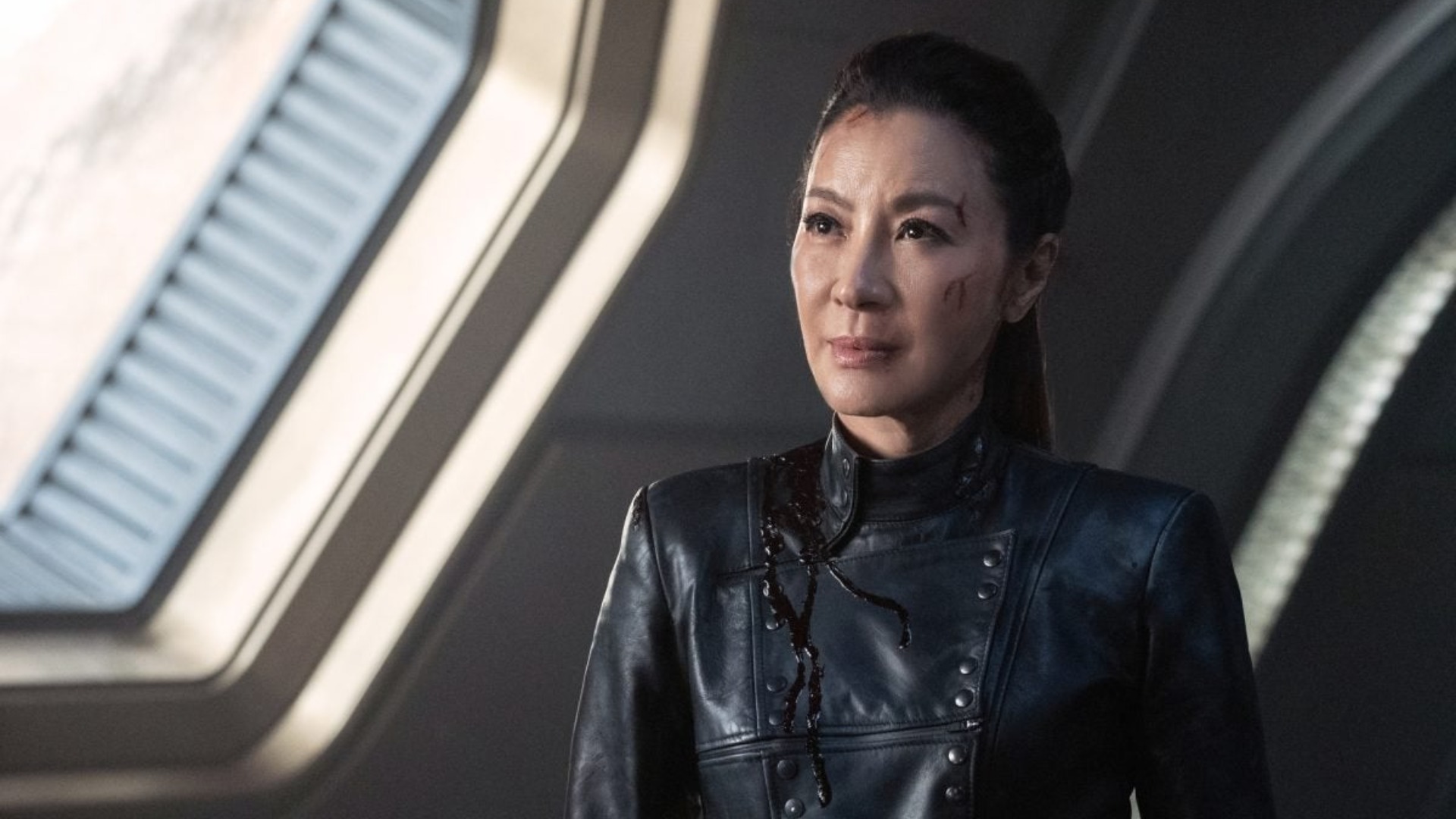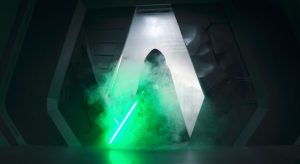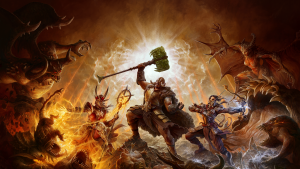
In 1966, Gene Roddenberry and his co-creators gave the world Star Trek, an adventure series that imagined humanity overcoming its racist and sexist and class divisions, which inaugurated a new age of exploration. Corny? Sure. Imperfect? Of course. But that fundamental optimism remains a key aspect of Star Trek, presenting a challenge to those future creators tasked with keeping the franchise alive beyond the years of its birth.
That doesn’t mean the optimism can’t be challenged or re-contextualized. Indeed, Star Trek: Deep Space Nine did exactly that, and many put that series at the top of their franchise rankings. But Deep Space Nine also introduced Section 31, a black ops organization within Starfleet and the darkest alternative to Star Trek optimism this side of the Terran Empire.
Sadly, later Trek creators have jumped onto the Section 31 concept, resulting in darker, much more pessimistic (and paranoid) stories that forget the best parts of great Star Trek adventures.
The Secret Origin of Section 31
Starfleet has always had its offshoot divisions, such as the Exploratory Division or Stellar Imaging Division, both commemorated on starship plaques. But Section 31 operates differently as an independent division that’s almost totally unknown to the rest of Starfleet.
Section 31 first reared its head in the Deep Space Nine season six episode “Inquisition,” written by Bradley Thompson and David Weddle and directed by Michael Dorn. Posing as Starfleet Internal Affairs, Luther Sloan attempts to recruit Bashir into Section 31, first by charging the Doctor with passing secrets to the Dominion and later by blackmailing him with evidence of his augments.
Played by character actor great William Sadler, Sloan became a regular feature in the final two seasons of Deep Space Nine, as did Section 31. The organization made sense in that series as the farthest limit that Starfleet would go to protect its vaunted ideals during a time of war. Even if the actual mechanics didn’t make sense (seriously, no one noticed or remembered these guys walking around Federation ships?), it worked on a thematic level for the show. Yes, Sisko could live with moral compromises in pursuit of protecting the rest of the Federation, but Section 31 showed both the extreme end and the limit for him.
In other words, Section 31 played a specific role within the specific circumstances of Deep Space Nine. The show put Starfleet in a totally new situation, pitting humanity against an enemy unlike any other. Showrunner Ira Steven Behr and the writers put Starfleet and Federation principles to the test. Although Sisko and his crew fell short of that test time and again, Section 31 stood as a reminder of what Starfleet would become if they ultimately failed.
That function is most pronounced in the resolution to the Dominion War. In the final episodes of DS9, Bashir discovers that the virus killing the Founders came from Section 31. Sloan had his team develop the virus and inject it into Odo while the Changeling was in Starfleet Medical care. When Odo joined the remaining Changelings in the Great Link, he spread the virus to them.
To hear Sloan tell it, the virus plot was necessary, as Starfleet and the Federation would be destroyed by the Dominion. When they fell, all their ideals would die with them. Sloan saw himself as an ironic hero, one who protects Starfleet and the Federation by violating its principles.
So devoted to this concept was Sloan that he committed suicide before Bashir could find a way to cure the virus. Rather than accepting defeat, Bashir maintained that most important of Federation ideals. He kept hope. He and Chief O’Brien worked tirelessly to find a cure, saving not only their friend Odo but what was left of the Changelings in the Great Link.
In short, DS9 showed Starfleet rejecting Section 31 and all it stood for. The series did not bring on Section 31 for cool action and edgy stories, but to reinforce the importance of Starfleet ideals. If only the rest of Trek did the same.
Star Trek (Deeper) Into Darkness
Things didn’t get too far out of hand, at first.
To retroactively explain the difference between Klingons on The Original Series and Klingons on The Next Generation, the Enterprise two-parter “Affliction” and “Divergence” had a reason to bring back Section 31. In this story, the secret division kidnaps Doctor Phlox to heal the augment virus (which is why the TOS Klingons look different) and gain an edge over Starfleet’s rival empire.
Again, no one necessarily needed an explanation (and the weird Discovery Klingons threw that all out the window anyway), but if you’re going to explain it, then Section 31 makes sense. Plus, the episode reveals Malcolm Reed’s association with the organization, which helped flesh out his character a bit more — something that anyone who wasn’t Archer, T’Pol, or Trip desperately needed. We can even accept Section 31 Harris showing up in later episodes to sabotage the proto-Federation.
The true problems with Section 31 became clear in the J. J. Abrams reboot movies. The 2009 Star Trek gets by with a breathless pace and glossy filmmaking, ensuring that everyone is having too much fun to get upset about the many shortcomings in the script by Roberto Orci and Alex Kurtzman.
But the wrongheaded 2013 sequel Star Trek Into Darkness positioned Section 31 as the movie’s big bad. Not only is Section 31 head Admiral Marcus the movie’s ultimate villain but the Kelvin Universe Khan Noonien Singh is a Section 31 agent, operating under the name John Harrison. The organization allowed Abrams and returning Orci and Kurtzman, now joined by Damon Lindelof, to indulge in the darker side of Trek, leaving behind the shiny optimism of the TOS-era they claimed to adapt.
Disastrous as Star Trek Into Darkness was, Kurtzman carried those ideals into his tenure as franchise head. For all of its wonderful weirdness, Star Trek: Discovery also really leaned into being dark and edgy in its first two, weaker seasons, focusing on the Mirror Universe for season one and then Section 31 in season two. Heck, it combined the two by making deposed Terran Emperor Philippa Georgiou into a Section 31 agent in the Prime Universe.
After the Discovery shoots into the future for its third season, Section 31 gets left behind (but not the secret forces undermining the Federation). But the division has popped in other new Trek shows since, albeit as a joke on Lower Decks. Even the largely upbeat third season of Picard could not resist invoking Section 31 in its DS9 callbacks, using Changelings who suffered the division’s experimentations during the Dominion War as secondary antagonists.
Still, despite the beauty of having Michelle Yeoh in the Star Trek universe, the prospect of a Section 31 movie starring her Georgiou seems more like a threat than a promise.
The Limits of Section 31
Section 31 defenders will insist that because the division has been involved in some good stories, which justifies the increased attention over the years. Indeed, the story of Trek is, in many ways, the story of exploring initially underserved aspects of the universe, whether it be characters such as Data and Seven of Nine or the Federation itself. Heck, the holodeck/holosuite episodes or the musical episode of Strange New Worlds are all extensions of the Earth-like planets that the Enterprise visited for budget reasons in TOS.
However, those worthy off-shoots worked because they lent themselves to the type of storytelling that Trek does best: fundamentally optimistic, about people overcoming their fear and prejudice to work together. As most time-travel episodes demonstrate, the optimism of Trek stands contrary to our current skeptical age. Darker, more grounded stories have more immediacy and can be more powerful, which is why Battlestar Galactica outdid Enterprise in the 2000s.
But as the world gets worse and the ideals of peace-seeking, community, and overcoming xenophobia become harder to see, Trek optimism grows all the more important. For all of his flaws, Roddenberry’s initial vision of humanity working together still resonates and is even more necessary today.
To be clear, I’m not saying that Section 31 should never come up again. However, it does present a temptation to Trek writers who can’t do the hard work of telling good stories in an optimistic future. Section 31 allows them to fall back on easy tropes about secrets and conflict, which work great in other settings, but undermine Trek.
Writers need to put Section 31 on the shelf for a while and explore other aspects of the universe, aspects that give us the hope we so desperately need today. And when they bring back the division, it should be used like it was in Deep Space Nine, as a limit that we cannot reach, a warning against the compromises we’re so often tempted to make.
Only then can Section 31 fit within the hopeful, unlikely, but oh-so-needed world of Star Trek.
Star Trek: Section 31, a streaming movie starring Michelle Yeoh, is currently in production and is set to release on Paramount+.
The post Why Star Trek Needs to Forget Section 31 appeared first on Den of Geek.






